Display
Super AMOLED once again, but the resolution is now full HD 1920 x 1080, which compares favorably to the 720p Note II. On a 4.5 to 4.7" phone, one could easily argue that 720p is plenty good, but at 5.7", 1080p is a must to achieve really smooth text and sharp looking photos. The 386 PPI Galaxy Note 3 doesn't disappoint there: text is indeed sharp, and despite the (improved) Pentile Matrix, I couldn't see individual pixels or halos on text. It's a lovely looking display with AMOLED's signature deep blacks, and whites are closer to white than ever for Super AMOLED. Outdoor visibility, a sore point for Samsung Super AMOLED displays has been improved with even higher max brightness, but there's a trick: you'll only get that augmented brightness if you step outdoors into the sunlight and have auto-brightness turned on. Samsung does this so you don't tank battery life by leaving it on super brightness all the time, but it's a bit annoying since I rarely enable auto-brightness since it's too dim for my liking. Even when that higher brightness kicks in, the display is a bit muddy in sunlight, and phones with IPS or Super LCD displays like the iPhone 5s, LG G2 and HTC One are much more viewable. Like some Nokia Lumia phones, the Note 3 has an option for heightened display sensitivity that works with gloved fingers.
But let's talk livin' large: this is the apex of big screen joy without carrying around something that feels like a tablet. The colorful (even if overly vibrant) display is superb for watching videos and viewing web pages. Movies are much more immersive at 5.7" and web pages require less zooming. How about eBooks? Though Super AMOLED isn't my favorite for long form reading, the Note 3 display is fairly color neutral and text is very sharp. Combine that with the big display and you get more words per page than on a smaller screen phone (without resorting to 6 point fonts). Sweet!
Calling and Data
Call quality on our AT&T review unit is excellent, just as with the Samsung Galaxy S4 and the Note 2. Incoming and outgoing voice are very clear and reasonably full and we heard no background hiss or white noise. Noise rejection is quite good thanks to the multiple mic setup. We tested a variety of popular Motorola, Samsung and Jawbone Bluetooth headsets as well as built-in BMW car Bluetooth and it worked perfectly with good volume and clarity.
Data speeds were excellent on AT&T's 4G LTE network in the Dallas area, and the phone averaged 18Mbps down and 12 Mbps up according to the Speedtest.net app. That matches the GS4, iPhone 5s and HTC One on the same carrier.
Samsung Galaxy Note 3 vs. the Competition
For those of you who own a Note 2 and likely still have a year to go before your contract is up for a subsidized renewal, I'd understand if you passed on the Note 3. Not that the Note 3 isn't faster with a higher resolution display and a better camera--but those are evolutionary changes, much as we see with other sequels. The Galaxy Note 2 is still a fast phone with a good looking and large display and the camera is pretty good. If you're faced with a $750 off contract purchase, moving from the Note 2 to Note 3 might be a daunting purchase unless you're well off and a smartphone enthusiast.
If you own a Samsung Galaxy S III or even the Galaxy S4 but really want a bigger display or the S Pen digital pen, then the Note 3 is an appealing move. However, if you find the GS4 is already pushing your hand and pocket's limits, the Galaxy Note 3 may feel too big.
How about the iPhone 5s? I'm still surprised that many of you are considering two phones that are so fundamentally different. Maybe you're considering these two because they represent the best of iOS vs. the best of phablets? The iPhone 5s is much smaller, runs a very different OS and has no pen. But just in case you're on the fence, watch our Note 3 vs. iPhone 5s comparison smackdown video above.
Camera
As far as we can tell, these are the same very good 2MP front and 13MP rear cameras used in the Samsung Galaxy S4. The rear camera takes extremely detailed and colorful photos. Low light? Not as impressive when compared to the HTC One and iPhone 5s with their larger sensor pixels. The camera has a BSI sensor, HDR mode for photos and both 4k and 1080p video recording. This is the first time we've seen 4k recording on a US phone and it does indeed capture added detail with a few caveats. The phone's processor can handle only so much, so features like simultaneous front-rear camera recording and digital image stabilization are disabled. We can easily live without dual camera recording, but without digital (or optical) image stabilization, videos are very jittery. You'll definitely want to sit or stand still rather than walk when shooting 4k video. The front 2 megapixel camera worked well for fairly clear and bright video chats.
Samsung's camera UI is excellent, and it's based on the Galaxy Camera's UI, and is the same as the GS4's. It's very easy to select between the various shooting modes and it's clear what each one does. Samsung's unique Drama mode stitches together several images taken in succession: perfect for sports or fast moving children and you'll end up with a photo of your subject moving across the frame. Sound & Shot is also cool: it captures a few seconds of sound when you take a photo. Well done. These accessible camera modes will tickle your creative funny bone. The end result is that you'll likely take more photos and have more fun looking at them afterward.
For more serious photographers, there are myriad settings and tweaking them can yield even better shots; hint: turn on digital video stabilization which is turned off by default, and play with the different photo metering modes for best exposure. Those who are serious photo buffs like me will appreciate the detailed photos, good overall exposure and lack of unwanted digital processing artifacts. The average user who just wants a bright shot with good contrast will also be pleased, but we found the default settings weren't always the best to capture the ideal shot.
Benchmarks
Note: we're still including our benchmarks section, but in light of Samsung's "cheating" to increase benchmark results by ~10% in all major benchmark programs except GFXBench by raising thermal ceilings and maximizing use of all cores, we're not going highlight the Note's 3's synthetic benchmark results.
| |
Quadrant |
GFXBench 2.7, 2.5 Egypt Offscreen |
AnTuTu |
Sunspider JavaScript Test |
| Samsung Galaxy Note 3 |
22,006 |
54 fps |
35,823 |
587 |
| Samsung Galaxy S5 |
23,643 |
N/A |
35,357 |
398 |
| LG G2 |
19,762 |
57 fps |
32,990 |
823 |
| Samsung Galaxy S4 |
12,276 |
41 fps |
24,776 |
826 |
| HTC One M8 |
24,527 |
N/A |
36,087 |
776 |
| HTC One M7 |
12,252 |
37 fps |
24,589 |
1155 |
| Sony Xperia Z |
7916 |
32 fps |
20,403 |
1306 |
| Moto X |
8357 |
43 fps |
21,377 |
1097 |
| LG Optimus G Pro |
11,994 |
28 fps |
18,561 |
867 |
| Samsung Galaxy Note 2 |
6001 |
66 pfs (v.2.5 used) |
14,056 |
1052 |
| LG Optimus G |
7235 |
59 pfs (v.2.5 used) |
11,087 |
1289 |
| Samsung Galaxy S3 |
5102 |
51 fps (v.2.5 used) |
7011 |
1825 |
3DMark, Ice Storm test (unlimited): 15,092.
Battery Life
Giant phones can have giant battery life. The Note 2 was no slouch and the Note 3 adds 100 mAh of capacity while doing a good job of juggling the demands of a 2.3GHz quad core CPU, 4G LTE and a 5.7" full HD display. The battery is removable, so you can purchase a spare and swap it in on the road. While other smartphone manufacturers are ditching removable batteries in droves, we can count on Samsung to provide this feature. The 3200 mAh Lithium Ion battery routinely lasted us 1.5 days on a charge with moderate use. That's better than most big screen flagship smartphones and the iPhone 5s with its much smaller battery--they generally last us a day of moderate use that includes 30 minutes of calls, streaming HD video for 45 minutes, playing music with the screen off for an hour, web browsing for an hour and checking email via push and IMAP idle.
Conclusion
The Samsung Galaxy Note 3 is king of the phablets, as was the Note II. Heck, before the original Galaxy Note, there was no such thing as a phablet. Good thing Samsung was cheeky enough to give oversized smartphones a try. The Note 3 is currently among the fastest phablets; only the Sony Xperia Z Ultra shares the Snapdragon 800 CPU with Adreno 330 graphics for now, though we expect that to change as the months pass. It's the only smartphone with a digital pen and active digitizer and it has a full HD display. Throw in Samsung's software, and you've got a powerful computer in your pocket that's big but not comically huge. Granted, we could live without some of that software, including the TouchWiz UI itself, but the pen software is top notch, Samsung's Multi Window split window multitasking is the best in the business and there are several enjoyable creature comforts like Air View. If you want a big screen smartphone (really big) and a digital pen, the Note 3 is your machine.
Website: www.samsung.com
Price: $299 to $350 with 2 year contract. Approximately $750 without contract.
Related:
Samsung Galaxy Note 5 Review
Samsung Galaxy S6 edge+ Review
Samsung Galaxy Mega 6.3 Review
iPhone 6 Plus Review
HTC One max Review
Nokia Lumia 1520 Review
LG G Flex 2 Review
Samsung Galaxy Note 2 Review
LG G2 Review
HTC One M9 Review
Samsung Galaxy Note 10.1 2014 Edition Review
Samsung Galaxy Tab Pro 8.4 Review
Samsung Galaxy Note 8.0 Review |
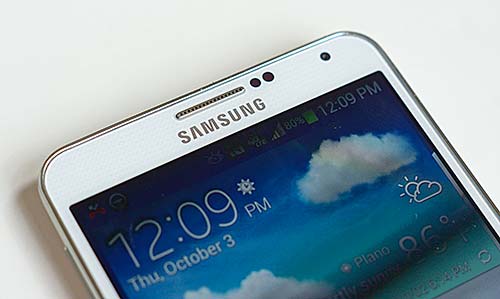
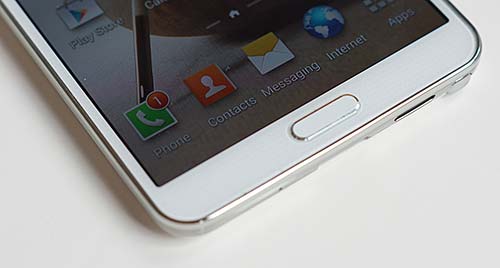
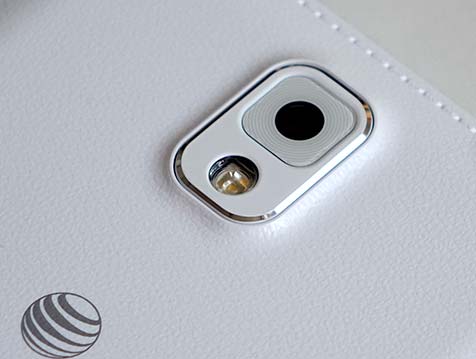
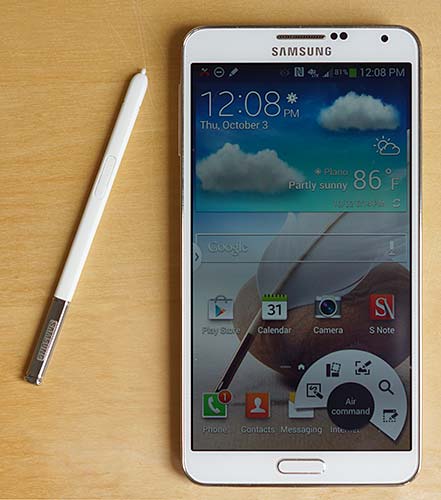
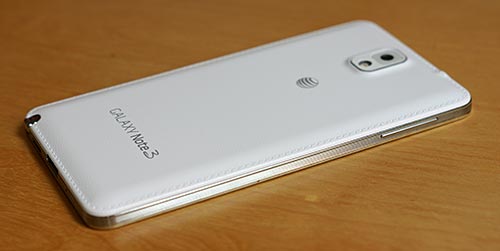

The Samsung Galaxy Note 3, Samsung Galaxy S4 and iPhone 5s. |

